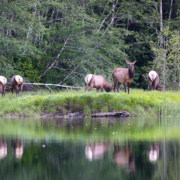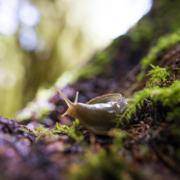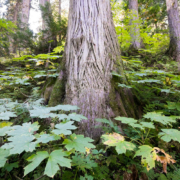Roosevelt Elk
Autumn is the season of romance for the magnificent Roosevelt elk of the coastal rainforest. Males “bugle” for females, and, wielding their massive antlers (which can host six or more pointed tines branching out from the main beam), contend with each other for access to mates. The Roosevelt elk is Vancouver Island’s largest and most charismatic land mammal, weighing up to 1100 lbs/500 kg! Both sexes of elk are easily distinguishable from other ungulates by a thick dark brown mane on their head and neck and beige body and rump. These large mammals are an important food source for wolves, cougars, and many First Nations people.
, Roosevelt elk spend winters browsing for woody plants such as devil’s club and elderberry along the banks of rivers in rich, valley-bottom forests. With their abundant shrubs and huge trees that block out the falling snow, old-growth forests provide Roosevelt elk with critical habitat, especially in the harsh winter months.
It is fitting that Vancouver Island’s largest land animal is drawn to the habitats that produce BC’s biggest trees: the nutrient-rich floodplains of coastal rivers. The sight of a herd of elk browsing in an old-growth riparian forest full of towering Sitka spruce and ancient moss-draped maples is the pinnacle of rainforest beauty and majesty: charismatic megafauna combined with charismatic megaflora!
With only around 3,000 Roosevelt elk on the island, they are considered a species of special concern by the province. The number one constraint on their population is the destruction of their old-growth wintering habitat, making the protection of our richest-valley bottom ancient forests an essential step in ensuring these magnificent creatures continue to roam our forests for generations to come.




